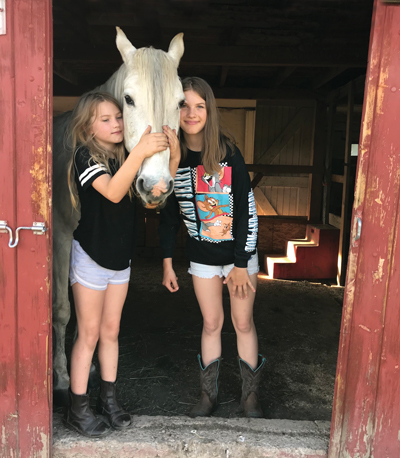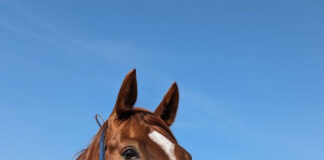
Dr. Diehl describes in her Vet Adventures column what happens next in life to a gray horse with a serious lameness diagnosis. Does he have hope for a good home?
Sadly, it seemed likely that Olaf would end up at an auction, and for a lame horse, this was an almost guaranteed trip to a Mexican slaughter plant. I promised to make some calls to see if I could find him a foster home, and Emily would try to buy him some time with the ranch owners.
Emily slowly led the large gelding away, and I watched his long tail swish gracefully, the sunlight gleaming off his coat. My heart was heavy as I packed up my equipment. I called everyone that I knew, put the word out on social media, and contacted local rescues, but no one wanted him.
Olaf’s New Home
The auction was approaching fast, and I hadn’t been able to come up with another option for Olaf. There was a glum silence as I told Emily the news. I still don’t know what got into me that day, but I surprised both of us by suddenly declaring that I would take him on and see what I could do for him. Emily was delighted and made me promise that I’d keep her posted on his progress.
Olaf arrived in good time and hopped out of the ranch trailer happily, his ears flicking in all directions. He called loudly to the horses out in the pasture who all came thundering in. Curious heads reached over the fence from all directions, but Olaf arched his shining neck proudly and strutted along the fence like the belle of the ball working a receiving line.
We got him settled into a small pen and I injected several of his joints, called the farrier out, and started a course of expensive medications. Maybe if I could get him rideable again, he could work out for my older daughter, who was in Pony Club and had outgrown her pony. Or maybe I’d just be the proud owner of a chronically lame, expensive and very large horse.
New Partners
Olaf had the entire winter off and enjoyed nonstop attention from both of my daughters. In early spring, I jogged him out and he trotted off grandly, his luxurious mane hanging almost to his shoulder and his forelock down to his nose. He was completely sound.
After a rehabilitation period under saddle, I decided to let Sunny try him out. She climbed bravely aboard the big horse, and he sniffed curiously at her leg.
Olaf moved carefully, aware of his small and precious cargo, and he was a perfect gentleman, trotting in 20-meter circles and stepping carefully over ground poles. It was an instant match, and Sunny was thrilled. She renamed him Atlas.
Atlas went to his first Pony Club lesson and was well-behaved and gentle. He and Sunny jogged jauntily around the arena, Atlas’ tail held proudly in the air and one ear always cocked towards his young rider. The instructor remarked on how honest he was, and Sunny beamed with pride. They had a wonderful season together.
Two Daughters, Two Ratings
A year later, Sunny took her D2 rating test on Atlas, and they passed with flying colors. Sunny wanted to start working towards the D3 rating, but it was apparent that Atlas was not going to be able to continue with her. The jumps were getting higher and more frequent, and he just wasn’t built for it.
My 8-year-old daughter, Morgan, had been riding our other horse and had just passed her D1 test. She was small but feisty for her age. I was hesitant to put her on Atlas, but she was ready to move up to a more spirited mount. We let her try him out in a lesson and it went perfectly.
Atlas was clearly entertained by his wee new mistress, lowering his head to her so she could hug him after the ride. He followed her closely as she bustled around the arena picking up manure piles.
Two years later, Morgan tested for her D2 rating with Atlas, who was now 17, and the big horse sailed through the riding portion effortlessly, earning a “Wow!” in a written comment from the examiner.
They had a delightful summer of trail riding, light jumping, and even riding double with friends. When Morgan was tired or cold, she’d drape herself over Atlas’ neck, and he’d stand peacefully, waiting until she was ready to ride some more.
A Diagnosis
I diagnosed Atlas with Cushing’s disease at the end of this last winter and started him on a drug called pergolide. His long coat wasn’t shedding out, and when the spring grass started to come in, I restricted his pasture access. But one day, he seemed uncomfortable. Despite the precautions, Atlas was in the early stages of laminitis.
He was moved to a dry paddock, and I treated the disease as aggressively as I dared. I had to tell Morgan that I didn’t think Atlas would be rideable for the summer. She took the news quietly, but I later found her crying in the tack room at the barn.
I was on a phone call a few days ago when something flashed past me in the indoor arena. I looked up to see Morgan and Atlas cantering bareback in circles, Atlas looking perfectly sound again.
I didn’t have the heart to scold Morgan. But after watching them for almost 20 minutes, I had a realization, and called Morgan’s instructor to let her know that Atlas had decided that he was coming back to lessons for another season.
It’s my 20th year in vet practice, and it’s just now beginning to dawn on me that the horses know more than I do.
This Vet Adventure column about taking in Olaf appeared in the August 2020 issue of Horse Illustrated magazine. Click here to subscribe!





